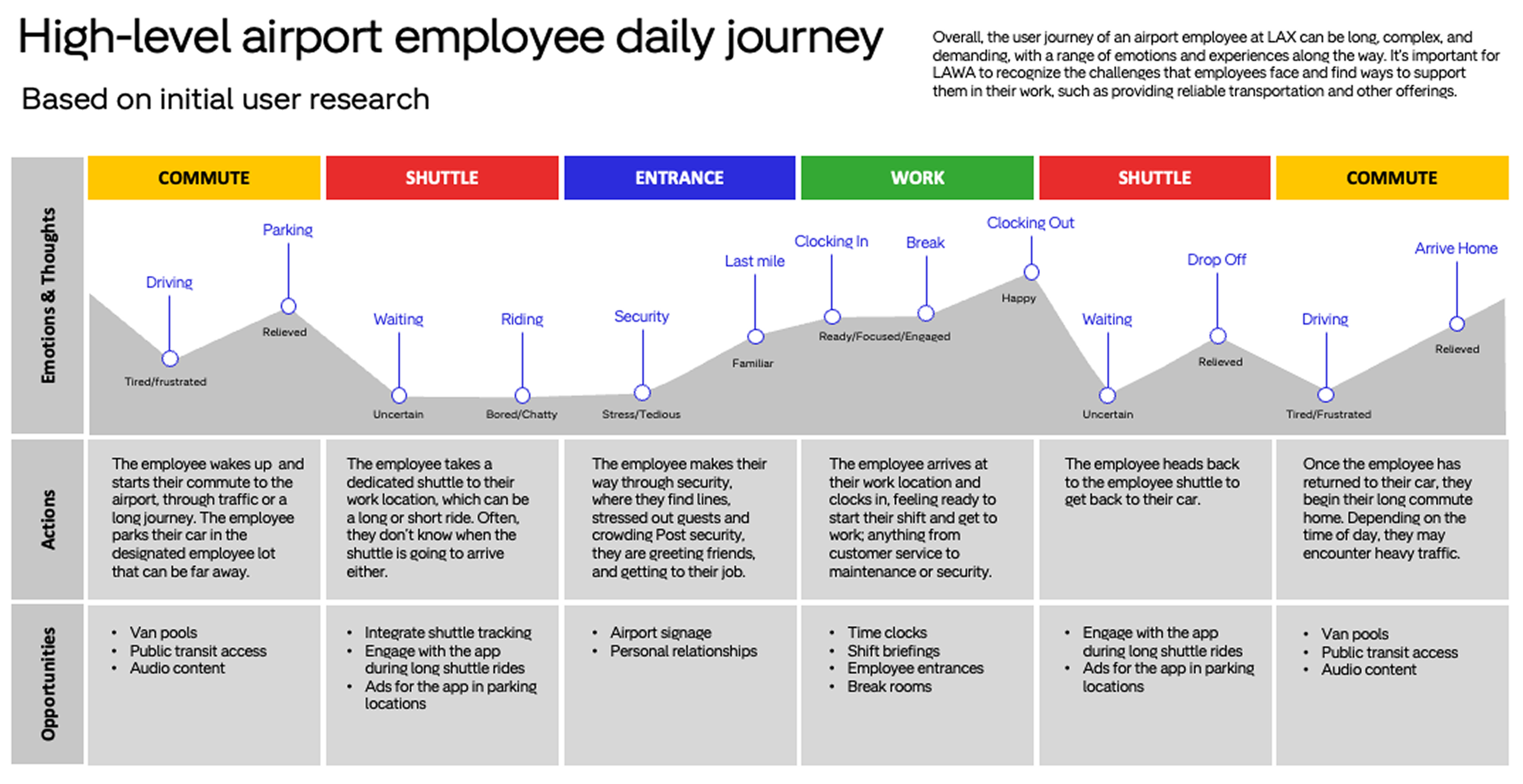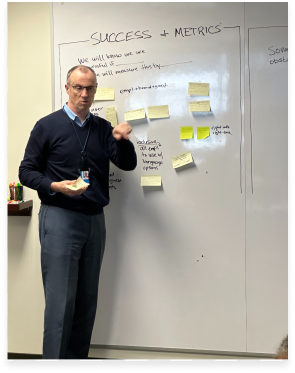Creating a digital tool to improve LAX employees’ workday
Los Angeles World Airports, the manager and operator of Los Angeles International Airport (LAX), sought to create a unified digital platform to support the diverse needs of the 40,000 airport workers that make LAX run everyday. Designit was tasked with designing and launching a web-app, that was named Altitude, to serve as a central hub for all employees.
ROLE & TEAM
My role: Client Design Director. As Client Design Director, I led the Designit team—providing strategic guidance and direction—while managing the client relationship to drive value and grow the account.
The team: Lead UX Designer, UX Designer, Lead Developer, Developer, Product Manager, Program Manager, QA Analyst, Data Analyst, Strategist, Creative Director
From the start, our client identified two key features they wanted in the MVP launch:
DISCOVERY & RESEARCH
Problem reporting: a central tool for employees to report issues around the airport
1
2
Service directory: a comprehensive list of contacts across the airport’s operations
We conducted user research to understand the varied needs and pain points across this diverse workforce and validate that these two features would address an employee need.
Through observational research and 20 interviews, we uncovered valuable insights that validated the inclusion of problem reporting and service directory features as essential components that could alleviate day-to-day challenges for airport workers. We also identified additional core insights through our research including:
Commuting is tiresome. Getting to the airport takes a while, and once employees arrive, when the employee shuttles are coming is not clear.
1
Information needs to be timely. Employees need up-to-date and accurate information in order to support a strong passenger experience.
2
Airports are expensive, even for employees. Employees noted how costly it is to work at an airport--from food to parking costs.
3
Reporting problems is not efficient. Reporting problems was like a game of telephone--many people had to be called before it’s routed to the right group.
4
Based on the research findings, a high-level user journey was drafted that showcased the end-to-end experience of an employee. It focused on emotions, the high level actions airport workers take and broad opportunity considerations.
USER JOURNEYS
With user insights on hand, an ideation workshop was hosted to generate potential features and solutions that would address employee needs.
IDEATION & TESTING
Based on our workshops, we created initial prototypes of features that could resolve airport worker’s pain-points. These prototypes included features such as problem reporting, service directory, airport discounts, translation services, and shuttle scheduling. We brought these prototypes into two rounds of user testing with 25 airport workers to determine if they truly met user needs, and to identify any if any critical improvements to the user experience needed to be made.
Employees did find value in a problem reporting and service directory feature.
INSIGHTS
Access to discounts would be beneficial, including ones outside of just food & beverage at the airport.
Detailed shuttle information like live-tracking, delays, and live pick up times could enhance the experience.
Employees are more likely to use the product if it is a website as opposed to native app.
Being able to call a translator service to help passengers was desirable.
As the experience for the web-app started to shape up, we kicked off branding efforts to help create a distinct look and feel for the tool, as well as a catchy name. Our focus was to create a distinct identity for the web-app that still felt connected to the broader LAX brand. We explored multiple visual directions, each designed to be a sub-brand of LAX, emphasizing unique elements that resonated with the diverse airport workforce while maintaining cohesion with the parent organization. This process included collaborative refinement sessions with our clients, ensuring the chosen direction reflected their vision and supported the web-app’s unique purpose.
BRANDING
Alongside the visual branding, we facilitated a naming exercise, ideating over 100 potential names for the web-app. To generate names, we used a variety of methodologies and shared best practice principles with our client.
It’s memorable. The best brand name is iconic, and one people can easily remember.
It’s accessible. It is easy to spell and pronounce, as well as search the URL online.
It’s meaningful. It represents what our brand stands for and conveys the benefits of our service.
It’s positive. It captures the imagination and connects positively with the employees.
It has longevity. It stands the test of time and positions LAX for bold growth and success.
It’s unique. It stands out from the rest and facilitates brand extensions with ease.
Through client collaboration, we narrowed down the options, ultimately selecting "Altitude," a name that conveyed a sense of elevation and support for the airport workers.
To determine the information architecture and prepare for design, we created various product and user flows to help support an intuitive and connected experience.
USER FLOWS
After 16 weeks of focused design and development, we launched a beta version of Altitude. This initial rollout was to a small group of 20 employees, which allowed us to gather valuable feedback and address potential issues before expanding to the entire workforce. Following the successful beta phase, the platform was fully launched to all airport employees at week 18.
LAUNCH
To drive awareness, targeted marketing campaigns were initiated. Posters were placed in employee-only areas of the airport to encourage workers to explore Altitude and engage with the platform, and swag items were handed out.
MARKETING CAMPAIGN
Altitude was continuously enhanced in agile sprints, with a focus on user feedback and evolving needs to ensure the web app consistently delivered value. Through ongoing user testing and agile development, regular updates were released based on real-time feedback and prioritized backlog features.
ENHANCEMENTS & ITERATIONS
Quick links
Refreshed homepage to get quick access to tools
FAQs
Get responses to passengers questions
Shuttle tracking
Live tracking of employee shuttles to get around
Discounts
Access to discounts at the airport and around LA
OUTCOMES & IMPACT
300%
increased usage in 6 months
80%
would use Altitude again
2x
Designit’s revenue with this client
Altitude not only drove measurable success—achieving a 300% increase in usage within six months and an 80% reuse intent—but also solidified our organization’s presence in the airports industry, a key priority sector. The success of the initial phase led to expanded engagements with LAX, including a second phase of Altitude and a strategy project focusing on the passenger experience. It also allowed our organization to open the doors with additional clients in the aviation industry, including JFK Terminal 4.





















